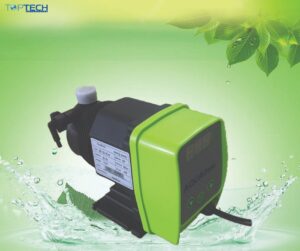What is a dosing pump?
A dosing pump is a device that delivers a precise and controlled amount of liquid. It is used in industries such as water treatment, chemical processing, and pharmaceuticals for accurate fluid dispensing and control. Dosing pumps can be automated or manual and come in various sizes and configurations to meet the needs of different applications and fluid types.
Parts of a Chemical Dosing System
A chemical dosing system typically consists of the following parts:
Dosing pump: It delivers a precise, metered amount of chemical into the fluid being treated.
Control panel: manages and adjusts the dosing rate and other operational settings.
Injection point: the location where the chemical is added into the fluid stream.
Suction and discharge lines: connect the dosing pump to the injection point and to the chemical supply.
Chemical storage tank: holds the to-be-dosed chemical solution.
Flow meter: measures the flow rate of the fluid being treated.
The suction and discharge lines’ pressures are monitored by a pressure gauge.
Safety relief valve: provides protection against over-pressurization.
Check valve: prevents fluid backflow.
The flow of chemical into the dosing pump is controlled by a solenoid valve.
Types of Dosing Pumps
There are several types of dosing pumps, including:
Diaphragm-driven dosing pumps use a flexible diaphragm to move fluid through the pump.
Peristaltic dosing pumps use rotating rollers to compress flexible tubing and move fluid through the pump.
Piston dosing pumps use a piston to move fluid through the pump.
Plunger-driven dosing pumps use a plunger to move fluid through the pump.
Screw-driven dosing pumps use a rotating screw to move fluid through the pump.
Electromagnetic dosing pumps: use an electromagnet to move a piston or diaphragm.
Hybrid dosing pumps combine elements from different types of dosing pumps.
The choice of dosing pump depends on the type of fluid being dispensed, flow rate requirements, and the operating conditions of the system. Read Water Treatment Plant
How do you calculate pump size?
Pump size calculation involves determining the flow rate and pressure requirements for a system, then selecting a pump with the necessary capacity to meet those requirements. Here are the steps to calculate pump size:
Determine the flow rate—the amount of fluid that needs to be moved in a given time period. This can be expressed in liters per minute (L/min) or gallons per minute (GPM).
Determine the pressure requirements: the amount of pressure needed to move the fluid from the starting point to the end point. This can be expressed in pounds per square inch (psi) or bars.
Consider the head loss: the pressure loss that occurs as fluid moves through pipes, fittings, and other components. This must be considered when calculating the required pressure.
Select a pump with the necessary capacity. Choose a pump with a flow rate and pressure capability that meet the system’s requirements, taking into account the head loss and any additional safety margins.
It is recommended to consult a professional engineer or pump supplier to properly size a pump and ensure optimal performance and efficiency.
A dosing pump is a device that delivers a controlled and precise amount of liquid, commonly used in industries such as water treatment, chemical processing, and pharmaceuticals. There are several types of dosing pumps, including diaphragm, peristaltic, piston, plunger, screw, electromagnetic, and hybrid pumps. The choice of pump depends on the type of fluid, flow rate, and operating conditions of the system. The size of a pump is calculated by determining the flow rate, pressure requirements, and head loss, then selecting a pump with the necessary capacity to meet those requirements. The price of dosing pumps can vary greatly depending on the size, features, and brand.

if you want but call our hot line visit contact page